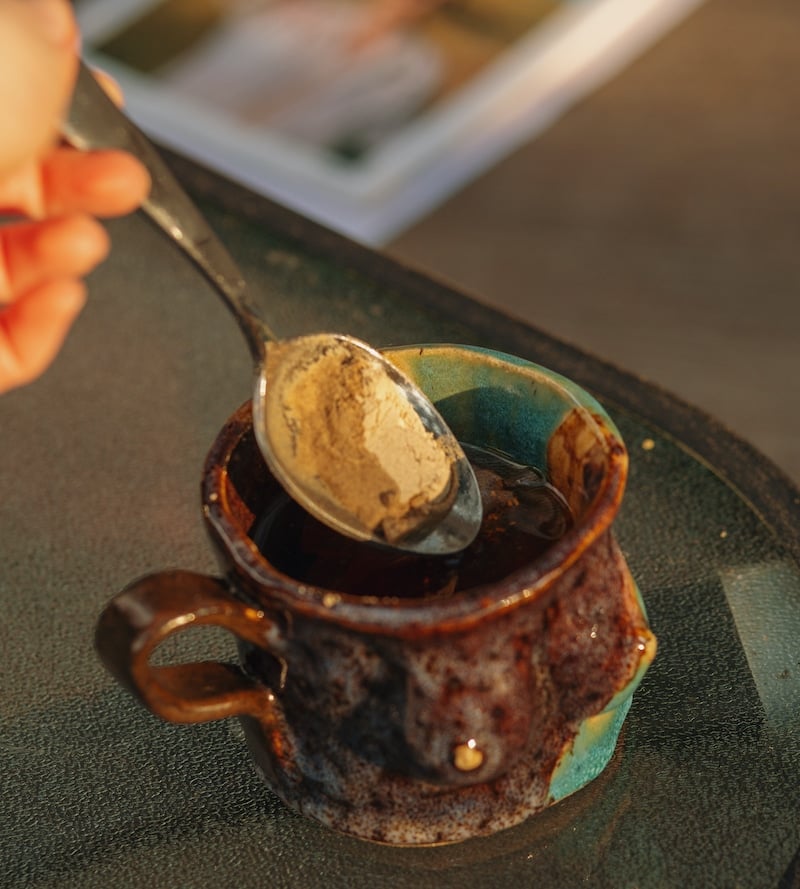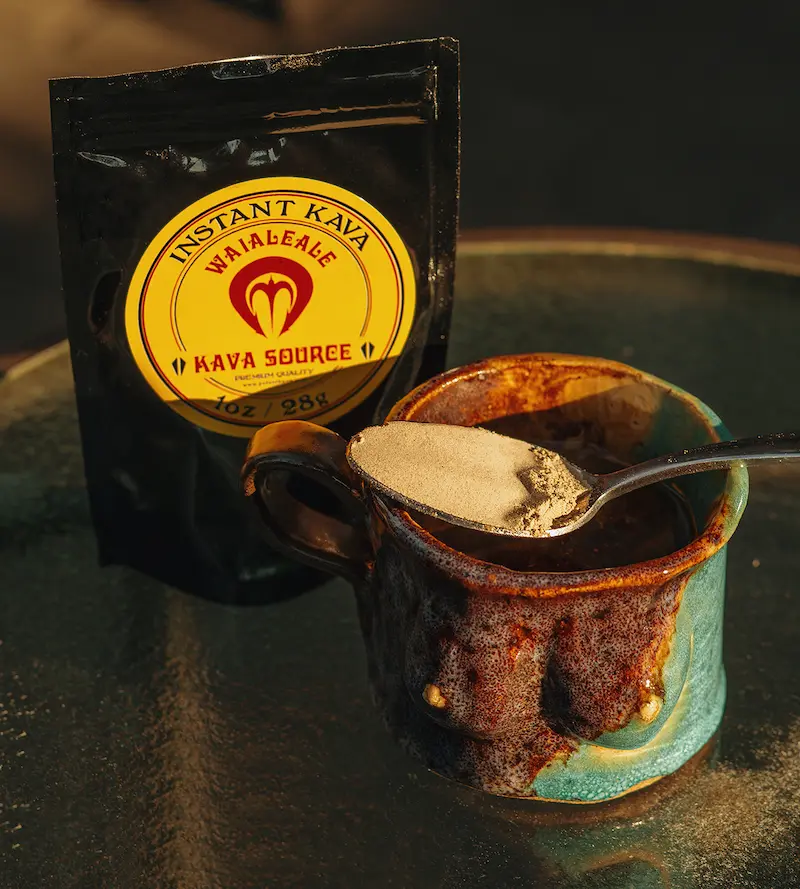The kava root stands in stark contrast to a world filled with Supersizes, Big Gulps, and mobile-order pickup. It imparts its wisdom slowly—it’s never too fast or too glutinous. Kava is rarely too potent or all-consuming and takes at least four years for its roots to mature (perhaps the plant’s own willful defiance against its new positioning as a cash crop). Kava is also particular about how it likes to be consumed—not too much and not too often, lest you find yourself ill. But, what exactly is this plant, and where does kava come from? Here are the kava basics everyone should know about.
What is Kava?
Kava (Piper methysticum) is an evergreen plant native to Polynesia, Micronesia, and Melanesia. Sometimes referred to as the “intoxicating pepper,” kava is a member of the Piperaceae plant family, including black peppercorns. But, it’s not seeds that make kava so valuable. Instead, it’s the root that takes the prize.
Kava root contains mild psychoactive compounds, which boast anxiety-relieving, analgesic, and sedative effects. But, the effectiveness and safety of the plant depend largely on how the root is prepared. Traditionally, kava root is pulverized and mixed with water or coconut milk to create a bitter, pasty drink—a concoction that dates back at least 2,000 years.
Where Does Kava Come From?
Some people like coffee and tea, others like kava. Kava comes from Oceana, where it both grows wild and is cultivated as an agricultural crop. It’s found in numerous Pacific Island regions, including the Republic of Vanuatu, Fiji, Tonga, Auckland, Samoa, Hawaii, and is also used by aboriginal communities in Northern Australia.
The name “kava” comes from Tonga and means “bitter.” Some of the earliest myths about kava come from the Tongan islands. As the legend goes, kava first grew on top of a grave of a woman who was sacrificed during a time of famine. The chief, called Loau, insisted that the woman not be eaten, but rather brought to him after her buried body transformed into a plant. Similar legends prevail in Samoa, Vanuatu, and Fiji.
Now, however, global trade has dramatically changed the agricultural landscape for kava. Before global trade, the plant was most often consumed by men and often reserved for elites or special occasions. Now, many of the traditional customs around kava are changing. For example, as BBC reports, women in Vanuatu were not culturally permitted to drink the Kava in the past.
How to Grow Shrooms Bundle
Take Both of Our Courses and Save $90!
Today, most of the world’s kava comes from two countries: the Republic of Vanuatu and Fiji. And the plant has quickly risen to become the third-largest agricultural export in the small island countries. In 2016, the two countries exported a reported 1,100 tonnes of kava, and the numbers are expected to grow. But, Vanuatu and Fiji are far from the only exporters of the root. Kava is a blossoming agricultural crop in Hawaii, which isn’t surprising—the United States, and more specifically, California, is the world’s largest importer.
What is Kava Used For?
Kava is used differently in the West than in the Pacific Island countries where it hails from. The plant has a long history of ceremonial, spiritual, medicinal, and social use throughout Oceania. Traditionally, kava is also a celebratory and ceremonial treat—it’s made during birthdays, graduations, and other big events. It’s a type of drink reserved for special events or prepared to welcome guests. In some places, like Tonga and Auckland, it’s also consumed at Church.
The bitter root also has a medicinal history, thanks to its ability to inspire a restful slumber and perhaps ease pain. But, more and more, kava is seen as a social lubricant in the Pacific Islands. In Tonga, for example, the root is most often consumed in kava social clubs, acting as an alternative of sorts to coffee shops, tea houses, and bars.
In the U.S., the biggest importer of the root, kava bars haven’t quite caught on. Instead, it’s the plant’s medicinal qualities that often make headlines. Today, most consumers pick up kava for health and wellness purposes—the root can ease anxiety, reduce stress, and has some analgesic properties.

Types of Kava
Like grapes, coffee, and cannabis, kava plants are developing terroir. There are many different varieties of kava, and each may develop different chemical characteristics depending on its cultivation environment. For example, the islands of Vanuatu are home to over two dozen different varieties of kava. But, in general, kava is separated into two broad categories: “noble” and “tudei.”
Noble vs. Tudei Kava
There are distinct differences between “noble” and “tudei” kava varieties from Vanuatu. The former is considered higher quality and is the most common export. It’s the only variety, in fact, that the World Health Organization recommends for export. The latter, tudei, is notorious for inspiring sleepiness that lasts for “two days.” Tudei kava is also illegal to ship outside Vanuatu. Instead, it’s reserved for ceremonial use. To help maintain the quality of kava and create standards for export, Fiji opened the world’s first kava tissue laboratory in 2019.
What Does Kava Do?
Kava is mildly psychoactive and hypnotic. And, when we say mild, we mean it. When used appropriately, kava will not spark delirium or hallucinations or cause a major shift in how you see the world. But, it might make your mouth feel numb. It also can inspire relaxation, pleasant mood, sleepiness, and general feelings of well-being.
Benefits of Kava
Kava’s mild psychoactivity is caused by a unique group of chemical compounds called kavalactones. Scientists have identified 18 different kavalactones thus far, several of which are being explored for their potential in medicine. Here’s a brief summary of the main benefits of kava:
Kava for Anxiety
For non-islanders, anxiety is the most common reason people use kava. And for good reason—kavalactones beat out placebos more than once in double-blind clinical trials. For this reason, many natural and integrative medicine practitioners will recommend kava as a natural anxiety aid.
Kava for Insomnia
Apart from anxiety, sleep is the second most-studied benefit of kava. In general, drowsiness is a common side effect of kava. As such, it’s not surprising that many people believe that kava inspires better sleep. Emerging evidence suggests that kava may be particularly useful in easing stress-related insomnia, which is often a concurrent side effect of anxiety.
Kava for Pain Relief, Headaches, and more
Kava is traditionally used for far more than Western science has adequately studied. Right now, medical literature suggests two possible uses for kava: anxiety and sleep. But, many consumers use kava for various ailments, including pain, headache, and menstrual issues.
In the Pacific Islands, the root is often used as an analgesic. Kava is sometimes used as a dental aid, relieving pain from canker sores and toothache. (Numbness of the mouth is one of the most common side effects after drinking kava.) Gout, arthritic conditions, gonorrhea, and urinary tract infections also make the list.
Unfortunately, however, these uses of kava are understudied in contemporary science. Right now, the best that we can say is that kava may share similar properties to aspirin when it comes to managing pain. It may also boast antibacterial properties.
Is Kava Safe?
The science behind the safety of kava is ripe with controversy. Germany banned kava in 2002, and other European countries followed suit. In 2002, Canada issued a “stop sale” on kava, preventing the legal sale of the root across the country.
Health officials cited public health as the reason behind the bans. Western scientists found that kava extracts were toxic to the liver—so much so that some consumers developed life-threatening liver damage. But, here’s the catch: Kava has been used traditionally for over 2,000 years, without reports of liver toxicity.
In the early 2000s, European researchers studying kava used isolated and extracted compounds in their research. Extraction is the process of separating and purifying the active chemical compounds in a plant, like separating caffeine from coffee beans. In the case of kava, this meant extracting kavalactones.
How to Grow Shrooms Bundle
Take Both of Our Courses and Save $90!
But, kava extracts didn’t work as expected.
Read: Why Kava is a Beautiful, Legal Way to Treat Anxiety, Build Community, and Create Ritual
Instead, Western alcohol and acetone extracts of the kava plant were more toxic than traditional preparations. In a seminal paper on the topic, Peter Whitton and a team of researchers from Phyto-Research, a private institution in the United Kingdom, postulate that there is a synergistic interaction among the chemical compounds in Kava root (namely, kavalactones and glutathione).
Modern extraction techniques, the authors suggest, remove glutathione from the extract. Glutathione is a potent antioxidant that may protect liver cells from damage. So, as Whitton’s theory implies, traditional preparations of kava naturally contain kavalactones but also contain the antioxidants that ensure its relative safety. Traditional preparations are also far less concentrated and made only with kava root, which also contributes to their safety.
But Whitton’s theory isn’t without critique. Other scholars pushed back against Whitton’s work, arguing that it implies that kavalactones themselves are harmful to the liver—a claim that scientists have a hard time proving. While there are at least 100 known cases of kava-induced liver toxicity, no one has been able to state that kavalactones, or other kava compounds, are the definitive culprits. As such, Canada lifted its kava ban in 2012, and Germany followed suit in 2014.
Given all of the confusion and back-and-forth from academic circles, the consumer ends up most confused. When in doubt, make your kava the traditional way—with water.

Kava Side Effects
Overall, the safety of kava depends primarily on the overall quality of the product and how the kava is processed. Many consumers equate standardized dosages, gel caps, and alcohol extracts with higher quality products. With kava, however, this might not be the case. As it turns out, mixing kava root powder into a beverage may actually be the safest way to consume the plant.
Liver toxicity
Some kava compounds may produce liver toxicity, especially when consumed in high doses. In the worst-case scenario, liver damage can be fatal. For this reason, it is important to consume water-based kava preparations and avoid kava products made from any above-ground portion of the plant. It’s also wise to avoid kava if you already have liver disease, as well as avoid the long-term use of kava if you’re already taking medications that may affect the liver.
Skin scales
Apart from potential liver toxicity, scaly skin is one of kava’s most common side effects. The condition is known as kava dermopathy, which can leave your skin feeling dry, flaky, and itchy. Kava dermopathy most often occurs when consumers use high doses of kava for extended periods of time. Unlike liver toxicity, kava dermopathy is a known side effect of regular kava use even in a traditional setting.
Bloodshot eyes
Drinking too much kava in the long-term can also cause red-eye, not unlike another famous psychoactive plant: cannabis. Only, with kava, these symptoms may last longer than just a few hours. Instead, bloodshot eyes are a sign of kava overdose or toxicity.
Other Side Effects
Overdosing on kava can cause a range of side effects. Apart from liver toxicity, some of the acute side effects may include headache, nausea, jaundice, and fatigue.
How is Kava Made?
The traditional way to consume kava is in tea. To make kava, farmers harvest the plant’s roots after four to eight years of growth. After harvest, the roots are washed, dried, and then ground into a powder. In Pacific Island kava bars and social clubs, ground kava root is mixed with water and/or coconut milk and soaked in a large communal bowl for several hours. Kava tea is often served in coconut shells.
Outside the Pacific Islands, however, kava is made a little differently. Unless you have an ample supply of kava root hanging around, most kava tea is made from pre-packaged root powders. To make kava tea with a prepackaged powder, you must add water, mix, and strain.
Kava Tea Recipe
Kava powder can be added to almost any water-based drink. In the United States, where there is no kava ban, kava has become a trendy ingredient in lattes, smoothies, and other water-based wellness drinks. But, preparing the root with water or coconut milk is still among the easiest ways to enjoy kava’s relaxing effects. Here’s how to make your own kava tea:
Ingredients:
- 1 cup warm water (or coconut milk)
- 2 TBS kava root
- Any additional flavorings you would like to try
Method:
- Whisk or blend kava powder with one cup of warm water with a blender
- Strain kava out root with fine cheesecloth or strainer
- Sweeten or flavor to your liking
Then, enjoy it!
How Much Kava Should I Take?
Dosing kava can be a challenge. Like most plants, every root will contain different levels of active kavalactones. So, every tablespoon of dried kava powder will contain a different amount of active ingredient. In general, most kava recipes recommend roughly two tablespoons of kava powder per every one cup of water or coconut milk.
However, medical professionals suggest limiting the daily dose of kavalactones to less than 250 milligrams to avoid unwanted effects on the liver. In general, kavalactones make up between three and 20 percent of the weight of the root. So, suppose you’re using a root powder. In that case, you can get a very rough estimate about the dosage of kavalactones you’re consuming by multiplying your serving size in grams (e.g. 30 grams) by the estimated percentage of kavalactones (e.g. around 20 percent).
The Bottom Line
It’s impossible to divorce the story of kava from the story of globalization. The sacred plant, traditionally used to strengthen community bonds and offer spiritual guidance, now traverses the world as a product. And the change is bittersweet—people worldwide now have access to the root’s slow and gentle nature, perhaps inspiring a much-needed moment of pause and reflection. But, at the same time, it’s tradition that makes the plant safe and healthy to consume. And tradition is often overlooked in the fast-paced world of commodities and global trade.
Let’s not forget.
Author’s note: It’s important to acknowledge that the sources of much of the economic and health information reported in this piece, and other pieces about kava, come from traditions disrupted by colonialism. If you are passionate about kava and want to participate in how the plant’s history is represented, please write and share!
Interested in having a psychedelic experience, but don't know where to start? Get our definitive guide on trusted legal retreat centers, clinical trials, therapists, and more.
We started DoubleBlind two years ago at a time when even the largest magazines and media companies were cutting staff and going out of business. At the time we made a commitment: we will never have a paywall, we will never rely on advertisers we don’t believe in to fund our reporting, and we will always be accessible via email and social media to support people for free on their journeys with plant medicines.
To help us do this, if you feel called and can afford it, we ask you to consider becoming a monthly member and supporting our work. In exchange, you'll receive a subscription to our print magazine, monthly calls with leading psychedelic experts, access to our psychedelic community, and much more.



